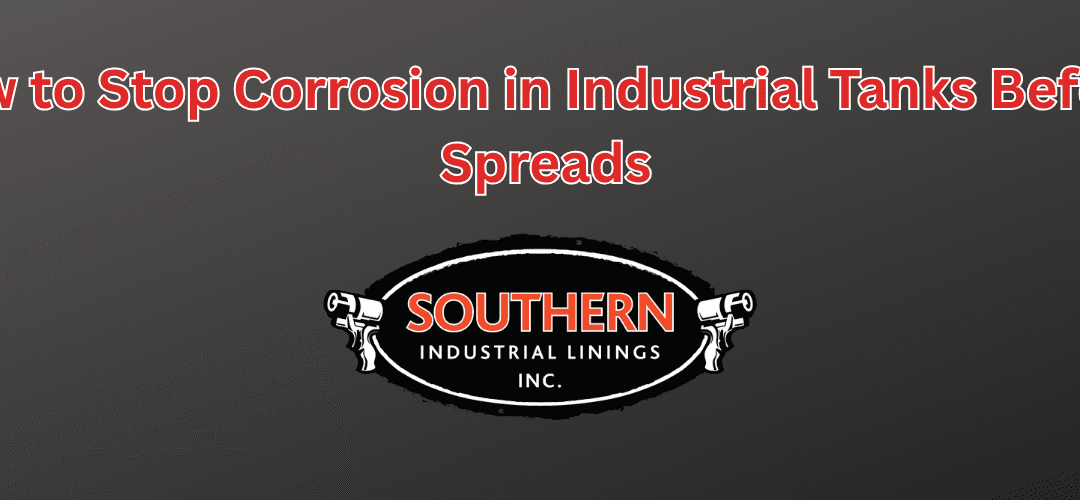One thing we see day in and day out in our work across the Southeast, in places like Virginia, Georgia, the Carolinas, and even Alabama, is that corrosion is more than a maintenance issue—it’s a profit killer. When industrial tanks begin to degrade, the damage doesn’t stop on its own. It accelerates. What starts as minor surface corrosion can quickly turn into leaks, contamination, compliance failures, and costly shutdowns. Every day a corroded tank remains in service is a day closer to an unplanned outage.
The good news? Corrosion can be stopped and controlled with the right protection strategy. This guide explains why corrosion spreads, what causes coatings to fail, and how to stop the damage before it destroys your asset or your budget.
Corrosion: A Cost and Downtime Problem First, a Structural Problem Second
When corrosion reaches a tank’s structural surface, two costs begin compounding:
| Cost Impact | Result |
| Operational Losses | Downtime, delays, and stoppages |
| Maintenance Escalation | Faster degradation and more expensive repairs |
Industrial operators know the rule: The longer corrosion goes untreated, the more expensive it becomes to fix.
Unchecked corrosion can lead to:
- Tank shutdowns and prolonged outages
- Emergency repair costs
- Contamination or product loss
- Structural failure
- SPCC and compliance violations
- Premature tank replacement (the most expensive outcome)
Stopping corrosion early isn’t just smart maintenance—it’s financial protection.
Why Tank Corrosion Spreads (Common Root Causes)
Corrosion spreads when the protective barrier between the substrate and the environment is compromised. The most common contributors include:
- Coating Breakdown
Old, rigid, or thin coatings crack, peel, blister, or delaminate—exposing raw steel or concrete. - Chemical Exposure
Aggressive substances found in industrial, chemical, and wastewater environments attack unprotected surfaces rapidly. - Moisture and Oxygen Intrusion
Once moisture reaches steel or porous concrete, corrosion accelerates exponentially. - Improper Surface Preparation
Coatings fail early if the substrate wasn’t blasted, cleaned, or profiled properly. - Thermal or Structural Movement
Tanks expand, contract, vibrate, and flex. Rigid coatings can’t handle the movement.
How to Stop Corrosion Before It Forces a Shutdown
Stopping corrosion requires both immediate stabilization and long-term surface protection. The most effective approach is:
Step 1: Identify the Source and Severity
Inspect corrosion points and determine whether failure is due to:
- Coating age
- Chemical exposure
- Substrate damage
- Improper past preparation
A quick assessment tells you whether you need spot repair, partial lining, or full relining.
Step 2: Repair and Restore the Surface
Corroded steel or concrete must be brought back to a sound surface. This includes:
- Abrasive blasting (SSPC/NACE prep)
- Removing rust, scale, and failed coating
- Repairing pits, cracks, or damaged areas
Step 3: Install a High-Performance Lining System
This is where most facilities either solve corrosion or repeat it.
To stop corrosion long-term, tanks need a seamless, chemical-resistant membrane that:
- Bonds tightly to the substrate
- Prevents moisture intrusion
- Resists chemicals and abrasion
- Flexes with tank movement
This is where polyurea lining systems outperform traditional coatings like epoxy.
Why Polyurea Stops Corrosion Better Than Traditional Coatings
Polyurea is specifically engineered for high-stress industrial environments where corrosion is aggressive and conditions are unforgiving.
Polyurea Benefits for Corrosion Control:
| Advantage | Why It Matters |
| Seamless Membrane | No joints or weak points where corrosion begins |
| Fast Cure Time (Seconds) | Tanks return to service faster—less downtime |
| Extreme Flexibility | Absorbs movement, vibration, and thermal expansion |
| Chemical & Abrasion Resistant | Ideal for aggressive tank environments |
| Long-Term Durability | Lower lifetime maintenance cost |
Unlike epoxy—which can crack, chip, or become brittle over time—polyurea moves with the structure and provides a long-term barrier that actually prevents future corrosion.
Learn more about our Industrial Tank Lining and Repair services.
FAQ: Stopping Tank Corrosion
Q: Can corrosion be stopped once it has started?
A: Yes—if the surface is properly repaired and a high-performance lining is installed.
Q: Do I have to replace a corroded tank?
A: Not usually. Most corroded tanks can be restored and relined for a fraction of replacement cost.
Q: How fast can a tank return to service?
A: With polyurea, often within hours, not days.
Final Takeaway + CTA
Corrosion doesn’t slow down—and it doesn’t stop on its own. The most cost-effective solution is to address corrosion early and protect the surface with a seamless, long-lasting lining system.
Southern Industrial Linings helps facilities stop corrosion, prevent shutdowns, and protect critical tank infrastructure for the long term.


